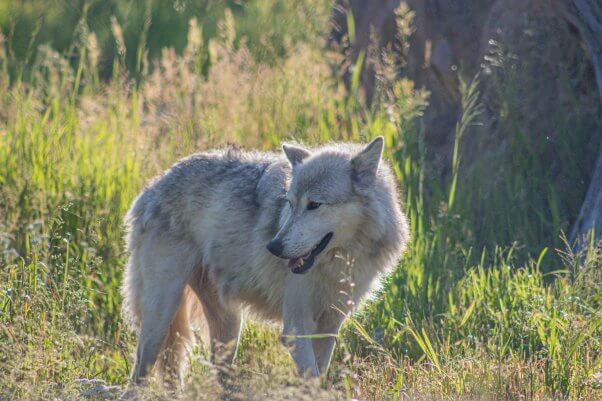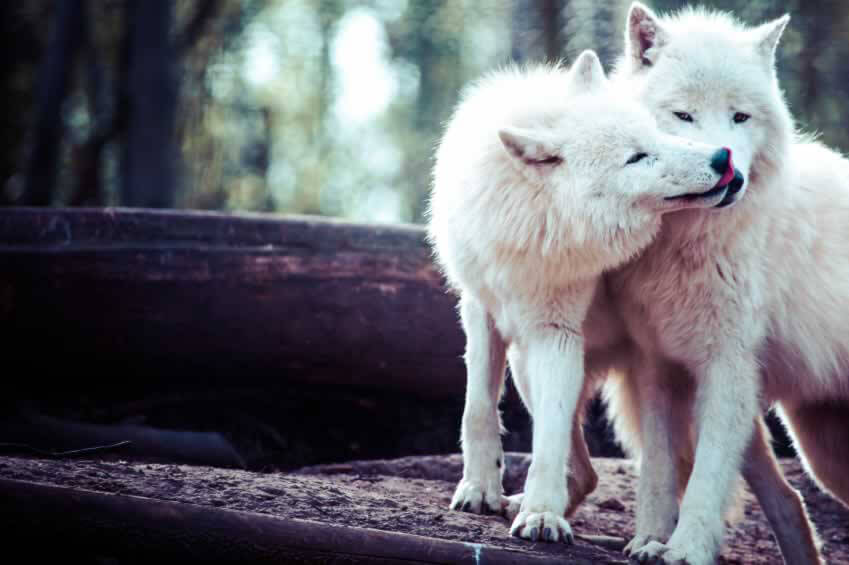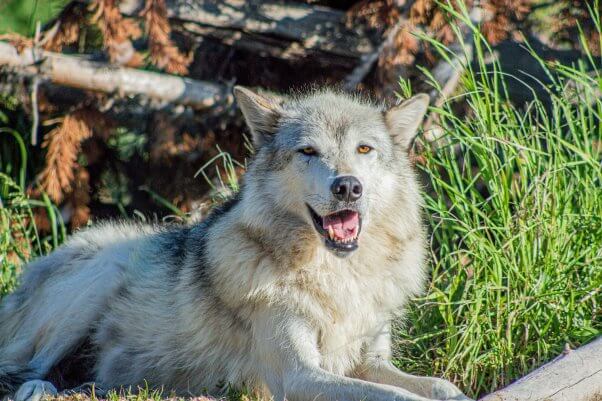Killer Barely Even Fined: Why Our Laws Must Change to Protect Wolves
In February, the U.S. Fish and Wildlife Service announced that it was declining to relist Northern Rocky gray wolves under the Endangered Species Act despite ongoing massacres of these animals in Idaho and Montana.
On April 7, 10 wildlife groups sued in a Montana federal court over the agency’s failure to relist wolves as endangered in Montana and Idaho. The following day, the same Montana federal court received a complaint for the failure to relist all Northern Rocky wolves.
Since wolves mate for life, remain faithful to their partners, and live in close-knit packs in which everyone pitches in, killing even a single wolf ruins multiple lives. Please take action to help wolves in Yellowstone National Park and wolf packs across the U.S.—then keep reading to learn more about wolves in danger and how you can help them:
Wyoming Wolf-Tormentor Gets Away With Murder
An alarming video of a captured, terrorized, tethered, and muzzled wolf lying in a broken heap inside a Wyoming bar has renewed concerns for these animals in parts of the U.S. where current laws don’t protect them. Replying to a public records request, the Wyoming Game and Fish Department released footage of the wolf tormented and later killed by Cody Roberts of Daniel, Wyoming.
Roberts was fined a mere $250 for illegally possessing the wolf. PETA asked law enforcement to investigate and file charges, and although many people demanded a far steeper penalty, disturbingly, most of what he did to the wolf is legal in Montana.
Yellowstone White Wolf Illegally Shot
In April 2024, according to National Park Service law enforcement, hikers discovered a mortally wounded white wolf—who was famous for being rarely seen in Yellowstone—near Gardiner, Montana. Park staff members responded, but due to the severity of the animal’s injuries, they euthanized her.
Weeks later, the results of a preliminary necropsy revealed that someone had illegally shot the wolf inside the park.
Although authorities haven’t officially announced a motive for the killing, some wolf advocacy groups suspect that opponents of wolves in Yellowstone are to blame. Over the years, many hunters and ranchers have expressed their disgruntlement over reintroducing these animals to the park.
In 2012, a hunter shot and killed Yellowstone’s most popular wolf, one of only three known white wolves in the park. According to park officials, she was an alpha female and had mated with the same alpha male for over nine years, giving birth to at least 20 pups, 14 of whom lived to be yearlings. Her death may have destabilized the future population growth and complex social structure of her pack.
Yellowstone Wolves in Danger
In 2022, hunters used food and electronic calls to lure gray wolves outside Yellowstone’s protective barrier. They blasted the animals with military-style rifles and pierced them with steel arrows. Throughout Montana and Idaho, hunters ran wolves down with snowmobiles and packs of dogs; caught them in limb-crushing traps and snares that slammed down on their necks, slowly strangling them to death; hunted them at night using bright lights to disorient and blind them; and gunned down sleeping pups in their dens.
In fall 2021 and winter 2021–2022, hunters killed 273 gray wolves in Montana. In 2021, during Idaho’s nearly year-round wolf-hunting season, hunters killed 495 of them. And those are just the kills that were reported.
Estimates indicate that there are only 5,000 to 6,000 wolves left in the entire continental U.S., and scientists fear that since illegal kills often go unreported, the actual death toll could be twice as high. Twenty-five of those killed were from Yellowstone—about a fifth of the park’s population. The celebrated Phantom Lake pack was almost completely wiped out.

Hunting Destroys Families
Both poaching and legalized hunting tear families apart and leave countless animals orphaned—or badly injured when hunters fail to kill them quickly.

Hunters kill millions of animals every year and have contributed to the extinction of species all over the world, including the Tasmanian tiger, the Zanzibar leopard, and the dodo. It’s common for hunters to injure but not kill animals, who often escape only to die slowly and painfully from blood loss or starvation.
Greed Fuels Hunting
The Intercept published the findings of a monthslong investigation into the events that led up to Montana’s mass slaughter of wolves, revealing that trophy-hunting special interest groups had spent big bucks to put one of their own in the Montana governor’s mansion in 2020 and stack the state’s Department of Fish, Wildlife and Parks. Under Gov. Greg Gianforte, regulations meant to protect wolves from annihilation fell like dominoes.
Meanwhile, hunting, trapping, and ranching interests in Idaho helped secure measures to allow for the massacre of up to 90% of that state’s 1,500 wolves and give the anti-wolf Idaho Fish and Game the power to draw up the exact plan.
Before the Endangered Species Act was passed in 1973, wolves had been so aggressively hunted, trapped, and poisoned that they were virtually nonexistent in the continental U.S. and among the first species to be given federal protection. A few years later, Northern Rocky Mountain gray wolves were delisted from the act. Hunters clamored for a shot at them, but advocacy groups fought back, and wolves retained some protection under state laws that prevented them from being killed in large numbers and by some of the cruelest methods.
Anti-wolf interests then accused the wolves of preying on farmed animals, even though U.S. Fish and Wildlife Service reports indicate that wolves kill only a handful of the nearly 9.6 billion land animals raised for food every year. Far more of them die due to health issues, giving birth, weather extremes, or poisoning. Even domesticated dogs kill more farmed animals than wolves do, including 100% more cows and over 1,900% more sheep. And ranchers are reimbursed for those “financial losses.”
Wolves and the Environment
Hunters blamed wolves for killing elk, even while turning out in droves to do so themselves. As reported by the U.S. Fish and Wildlife Service, the truth is that wolves help keep elk populations healthy by preying mainly on older females, who are no longer able to reproduce. By contrast, hunters typically target large bull elk of prime breeding age—the ones with a “trophy rack” of antlers.
And the remains that wolves leave behind provide many other species—including ravens, foxes, coyotes, bald eagles, and bears—with food. When elk herds change their grazing patterns to avoid wolf predation, it allows for the regrowth of willow, aspen, and cottonwood trees, which make excellent food for beavers and dwellings for songbirds. Wolves also help keep deer populations in check—another reason why hunters want them gone.
Killing wolves destroys entire ecosystems.

Wolf Populations Decimated
Armed with false narratives that claimed ranchers were being “put out of business” and elk herds were being stamped out, Montana and Idaho lawmakers declared open season on gray wolves.
After the Trump administration stripped wolves in the rest of the country of their Endangered Species Act protection in 2021, Wisconsin and other states followed suit, and the resulting carnage increasingly decimated wolf populations across the U.S.
But 21 U.S. senators, 60 conservation groups, nearly 200 tribal leaders, and more than 800 scientists implored the new Biden administration to stop the killing with an emergency order restoring wolves’ Endangered Species Act protection. The administration promised a yearlong review, resulting in a district court’s reinstatement of federal protection for wolves in 44 states—but the Northern Rocky Mountain wolves weren’t part of that ruling.
Montana and Idaho accelerated their plans for a mass extermination, and wolves don’t have much time. In May 2023, Idaho Fish and Game, despite most of the public comments it had received, approved a plan that would allow hunters and trappers to kill almost two-thirds of the state’s wolves. Only an estimated 500 individuals would be left. With such a small population, it could be difficult for wolves to maintain genetic diversity.
How You Can Help Wolves
Most U.S. residents oppose hunting, and like many blood sports, it’s dying out quickly as more people recognize that our fellow animals have unique personalities, love their families, value their own lives, and shouldn’t be hunted.
Tell everyone you know about the cruelty of hunting, encourage your legislators to enact wildlife protection laws, and insist that wildlife agencies have as many nonhunters as hunters on staff. Share this post to let your friends and family know where you stand on hunting. And urge legislators to pass laws that fully protect wolves everywhere.
The devastation that would be wrought by hunters in the Northern Rockies can’t be overestimated. Please send an urgent message to Secretary of the Interior Deb Haaland asking her to implement immediate emergency protections for gray wolves and to reinstate full federal protections for them under the Endangered Species Act.
Note: PETA supports animal rights, opposes all forms of animal exploitation, and informs the public on those issues. PETA does not directly or indirectly participate or intervene in any political campaign on behalf of or in opposition to any candidate for public office or any political party.

